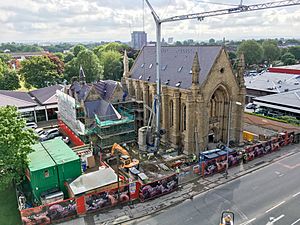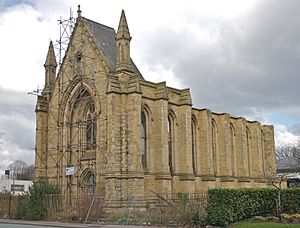Upper Brook Street Chapel, Manchester facts for kids
Quick facts for kids Upper Brook Street Chapel |
|
|---|---|

The chapel in 2017
|
|
| Religion | |
| Affiliation | Unitarian, then Baptist, then Jehovah's Witness, then Islamic |
| District | Chorlton-on-Medlock |
| Location | |
| Location | Upper Brook Street, Manchester, England |
| Architecture | |
| Architect(s) | Sir Charles Barry |
| Architectural style | Neogothic |
| Groundbreaking | 1837 |
| Completed | 1839 |
The Upper Brook Street Chapel is an old building in Manchester, England. It has been known by many names, including the Islamic Academy, the Unitarian Chapel, and the Welsh Baptist Chapel. This building was once a chapel, which is a place of worship, and it had a Sunday School attached to it.
It is famous for being one of the very first chapels built in the "neogothic" style for "Nonconformists". Nonconformists were Protestants who did not follow the official Church of England. The chapel was built for the British Unitarians between 1837 and 1839, right at the start of Queen Victoria's reign. It was designed by Sir Charles Barry, who later designed the famous Palace of Westminster (the Houses of Parliament).
The chapel has been a listed building since 1974, meaning it's an important historic site. It is currently owned by Manchester City Council. For a while, it was on a list of buildings at risk of falling apart. Part of it was even taken down in 2006 for safety reasons. The Victorian Society called it one of the most threatened buildings in England. Luckily, it was fixed up and turned into student homes in 2017.
Contents
What Does the Chapel Look Like?
The Upper Brook Street Chapel was designed by Sir Charles Barry. He designed it just before he started work on the Palace of Westminster. The chapel was built between 1837 and 1839. It is made of sandstone and has a slate roof.
Gothic Style Features
The building is in the English "neogothic" style. This means it looks like old Gothic churches, but it was built much later. It has seven narrow sections, each with strong supports called buttresses. Each section also has a tall, narrow window called a lancet.
The front of the building has a huge arched entrance. Inside this arch, there is a smaller arched doorway with a window above it. At the back of the chapel, there is a round window called a rose window. The corners of the building are square and have tall, pointed decorations called pinnacles.
Inside, the chapel used to have galleries on three sides. It also had a ceiling that looked like ribs, called a vaulted ceiling.
The Sunday School Building
The Sunday School building is attached to the chapel. It has two floors and looks similar to the chapel. One side of the Sunday School has three pointed roof sections, called gables. It also has large arched windows on the first floor. At one end, there's a rounded section called an apse and a small, sloping roof porch.
How the Chapel Changed Building Styles
This chapel was very important because it changed how Nonconformist churches were built. Before this, most Nonconformist chapels were made of brick and looked very plain. Some grander ones looked like ancient Greek buildings.
The Upper Brook Street Chapel is thought to be the first neogothic Nonconformist chapel. Another similar chapel, the Congregational Chapel, March, was built in 1836. After these two chapels were built, many new chapels started to look more like traditional parish churches.
The building was officially listed as a historic site on October 3, 1974. It is currently a Grade II* listed building, which means it is very important.
Who Used the Chapel?
The Upper Brook Street Chapel has been used by several different religious groups over the years.
The Unitarians
The chapel was first built for the Unitarians. It replaced their older chapel, the Mosley Street Chapel, which was torn down in 1836. The new chapel was used for important ceremonies like baptisms, burial rites, and marriages.
The chapel had a graveyard on both its north and south sides. People were buried there until 1882. Some graves from the north side were moved to brick vaults on the south side when the Sunday School was built in 1877. Baptisms continued until at least 1912, and marriages until at least 1916.
Several important ministers led services at the chapel. These included John James Tayler, William Henry Herford, Philip Wicksteed, John Trevor, and Edward Walker Sealy.
Other Religious Groups
The Unitarians sold the chapel in 1928 because the area around it was changing. After that, it became a Welsh Baptist Chapel. In the early 1970s, it was used by Jehovah's Witnesses as a Kingdom Hall.
Since the 1970s, Manchester City Council has owned the building. They bought the land hoping to build a large motorway, but that plan never happened.
Between 1974 and 2006, the chapel and Sunday School were used by the Islamic Academy of Manchester. During this time, it served as a mosque, a teaching center, and a place to help the local Asian community.
What Happened When the Chapel Was Abandoned?
At the start of the 2000s, the chapel's future looked uncertain. The building became unsafe, and a lot of money was needed for urgent repairs. In 2003, the Islamic Academy tried to get money from the Heritage Lottery Fund to fix it, but they were not successful.
In 2001 and 2005, the City Council got advice about the building's structure. With permission from English Heritage, they removed most of the roof for safety.
Parts of the chapel were taken down in early 2006 because they were unsafe. Scaffolding was put up to support other sections. By 2010, the chapel was on the Buildings at Risk Register, meaning it was in very bad condition. The Victorian Society listed it as one of the ten most threatened buildings in England.
The Chapel's New Life
In October 2010, Manchester City Council announced they were talking with a developer to fix up the building. In August 2013, a company called Church Converts (Manchester) asked for permission to repair the building and turn it into apartments. This plan was approved in February 2014.
The company CZero Developments worked on the project. They created 73 private apartments in both the chapel and the Sunday School.
Since September 2017, the building has been used as student accommodation. It now has a gym, a cinema room, study areas, and a lounge for students.
See also
- Grade II* listed buildings in Greater Manchester
- Listed buildings in Manchester-M13
- Dissenting Gothic, its architectural style



